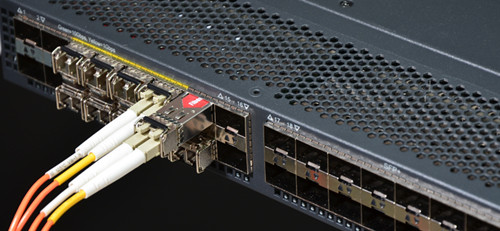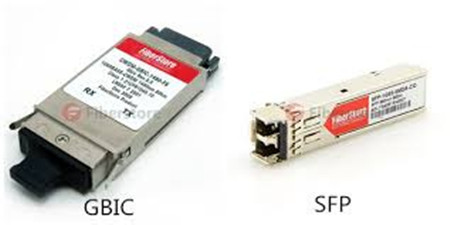SFP is a new generation of optical module transceivers. Featured by the compactness, flexible and economical design and high performance, SFP transceivers soon replace all the existing interface standards in networking after certification. To satisfy some projects, whose telecommunication equipment or networking device needs optical transceiver requirement. For better sharing SFP transceiver modules, this blog is illustrating knowledge of this hot-pluggable transceiver.
Small Form Factor Pluggable (SFP) Definition
The SFP transceiver is specified by Multisource Agreement (MSA), which was developed and followed by different transceiver manufacturers. SFP transceivers have a wide range of detachable interfaces to multimode or single-mode fiber optics, which allows users to select the appropriate transceiver according to the required optical range for the network.
Main Features of SFP Transceiver
SFP transceiver stands for Small Form-factor Pluggable transceiver. This transceiver is compact and hot-pluggable. It is widely used in the field of Data Communication and Networking. This transceiver mainly acts as an interface between a networking switch and its interconnecting cable as shown in Figure 1. This networking device can be any switch, repeater, router, multiplexer etc. The interconnecting cable may be made of copper or it can be an optical fiber cable. This transceiver which interfaces a device in the network to the cable is highly popular and can support devices and cables of various network vendors.

Superseding the GBIC transceiver, SFP modules are also called “mini-GBIC” due to their smaller size. By choosing the appropriate SFP module, the same electrical port on the switch can connect to fibers of different types and different wavelengths. If the fiber is upgraded, the SFP module is replaced.
Optical SFP transceivers come with digital monitoring features with the help of which one can monitor the performance of SFP in real time. This feature can be used to monitor SFP’s performance parameters like working temperature and wavelength, supply voltage, optical input and output etc. These transceivers have a PCB in them which connects to an electrical connector designed for SFP. SFP transceiver also has a 256 byte EEPROM memory. SFP transceivers are housed in a metal enclosure and their power dissipation is low. They operate over a wide temperature range and support a large number of different types of cable. An improved version of SFP standard called SFP+ can support transmission rates up to 10Gbps.
Certain SFP transceivers can also use copper cables as interface. This will cause a device in the network to send their data over shielded or unshielded twisted pair cable. Usually such copper cable interfaces are used when the information to be transmitted needs to cover only shorter distances where use of copper cable is more economical than optic fiber cables.
Types
SFP transceivers are of various types and each type comes with different configurations of transmitter and receiver. It is important to choose a proper transceiver to act as an interface between the device and the cable. This choice of transceiver is usually made based on the type of fiber optic cable. Such SFP transceivers which are used to provide the necessary reach to a fiber optic cable are categorized as optical SFP. These SFP modules are of several versions, wherein each version has different values of working wavelength and working distance: typical wavelength of different modules are 850 nm, 1310 nm and 1550 nm with working distances of 550m (SX), 10 km (LX) and 40 km (XD) respectively. J4858B and E1MG-LX-OM are 1000BASE-SX and 1000BASE-LX SFP, which are greatly welcomed by users. And there are also other types of SFP like DWDM, CWDM and bi-directional SFP with single fiber having upstream and downstream working wavelengths of 1310 nm and 1490 nm.
SFP vs. GIBC
SFP transceivers are compatible with a number of communication standards like Ethernet, SONET along with many other standards. SFP is an upgraded version of Gigabit Interface Converter (GBIC) module. SFP uses LC fiber optic cable for its interface whereas SC cable interfaces are used in GBIC. SFP is more space saving than GBIC, since the former has only half the size of the latter. SFP has transmission rate ranging from 100Mbps to 4Gbps and it can work at distances ranging between 500 meters to hundreds of kilometers. The ‘hot-pluggable’ feature of SFP makes it flexible. Any future changes can be easily incorporated into the SFP module, while the maintenance of the module is also made easier by this hot-pluggable nature of SFP, thereby making it compact.

XFP and SFP+ for 10 Gigabits
Larger than SFP, XFP transceivers were the first to handle 10 Gigabit Ethernet optical lines, because SFP supported only up to 4.25 Gbps. The same module size as SFP, SFP+ was later introduced to handle 10 Gbps but required more circuitry in the host device. As a result, SFP+ ports are mostly found in plug-in cards for servers and enterprise switches. See transceiver and GBIC. SFP+ and XFP Modules SFP Gigabit Ethernet and SFP+ 10 Gigabit Ethernet transceivers are the same size.
Summary
To sum up, SFP transceiver modules are designed for use with small form factor connectors, and offer high speed and physical compactness. Thus many telecom vendors have manufactured a variety of SFP transceivers to meet their common objectives of broad bandwidth, small physical size and mass, and ease of removal and replacement. Fiberstore also supplies a full range of SFP transceivers with competitive price and high quality.
评论
发表评论